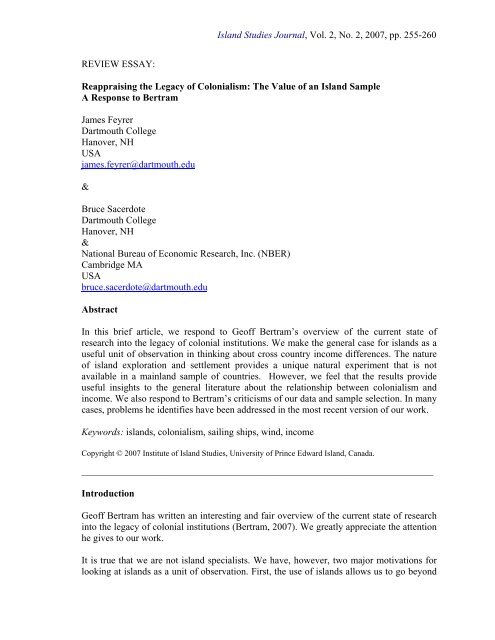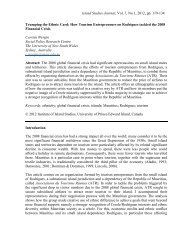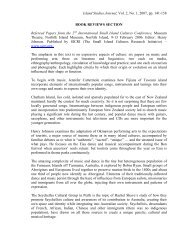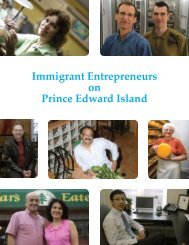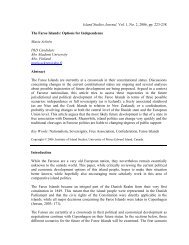Full Essay PDF - Island Studies.ca
Full Essay PDF - Island Studies.ca
Full Essay PDF - Island Studies.ca
- No tags were found...
Create successful ePaper yourself
Turn your PDF publications into a flip-book with our unique Google optimized e-Paper software.
<strong>Island</strong> <strong>Studies</strong> Journal, Vol. 2, No. 2, 2007, pp. 255-260REVIEW ESSAY:Reappraising the Legacy of Colonialism: The Value of an <strong>Island</strong> SampleA Response to BertramJames FeyrerDartmouth CollegeHanover, NHUSAjames.feyrer@dartmouth.edu&Bruce SacerdoteDartmouth CollegeHanover, NH&National Bureau of Economic Research, Inc. (NBER)Cambridge MAUSAbruce.sacerdote@dartmouth.eduAbstractIn this brief article, we respond to Geoff Bertram’s overview of the current state ofresearch into the legacy of colonial institutions. We make the general <strong>ca</strong>se for islands as auseful unit of observation in thinking about cross country income differences. The natureof island exploration and settlement provides a unique natural experiment that is notavailable in a mainland sample of countries. However, we feel that the results provideuseful insights to the general literature about the relationship between colonialism andincome. We also respond to Bertram’s criticisms of our data and sample selection. In many<strong>ca</strong>ses, problems he identifies have been addressed in the most recent version of our work.Keywords: islands, colonialism, sailing ships, wind, incomeCopyright © 2007 Institute of <strong>Island</strong> <strong>Studies</strong>, University of Prince Edward <strong>Island</strong>, Canada._______________________________________________________________________________________IntroductionGeoff Bertram has written an interesting and fair overview of the current state of researchinto the legacy of colonial institutions (Bertram, 2007). We greatly appreciate the attentionhe gives to our work.It is true that we are not island specialists. We have, however, two major motivations forlooking at islands as a unit of observation. First, the use of islands allows us to go beyond
J. Feyrer & B. Sacerdotethe standard data sets that have been used in empiri<strong>ca</strong>l investigations of economic growth.Since the Penn World Tables were first published, papers numbering in the thousands havebeen produced relying on this data. It is therefore very difficult to find new and interestingresults using the Penn World Tables.Second, finding <strong>ca</strong>usal relationships within cross country data is exceedingly difficult. Ofthe many studies written using the Penn World Tables, the vast majority are identifyingcorrelations, not <strong>ca</strong>usal relationships. As pointed out by Bertram, the most successfulpapers in this literature of late have been produced by Acemoglu et al. (2001; 2002). Theirinstrumental variable approach, using settler mortality as a predictor of moderninstitutions, is very clever. It is not, however, without its critics.The use of islands allows us to get to <strong>ca</strong>usal relationships in a much more straightforwardmanner. There are three characteristics of islands that were crucial for our study. First, theislands in our sample have much more homogenous initial conditions than continentalcountries. Second, the islands in our sample are small and remotely lo<strong>ca</strong>ted. Third, the onlyway to reach these islands during the colonial period was using sailing ships.The first two characteristics result in a signifi<strong>ca</strong>nt random component in the colonialhistory of islands. We start with a collection of small, similar islands spread out over a vastarea. Europeans were largely interested in getting across the Pacific, not staying there. Thecolonization of these islands is therefore going to be highly related to ease of travel acrossthe ocean and not so affected by the intrinsic productive <strong>ca</strong>pacity of the individual islands.This is heightened by the relative homogeneity of island geography (at least as comparedto mainland countries).This random component is the key to thinking about <strong>ca</strong>usality in our work. For continentalcountries, the timing and nature of colonialism is inextri<strong>ca</strong>bly linked to geographic factorswhich may be affecting output today. For the islands, this channel of reverse <strong>ca</strong>usality isarguably much weaker. The fact that islands are only accessible by sail during the colonialperiod is crucial for testing the hypothesis of randomness. By using wind patterns as aninstrument for length of colonial period, we are able to show that <strong>ca</strong>usality is indeedrunning from length of colonialism to income.MechanismsMoving from the basic result to a more detailed institutional analysis is unfortunatelydifficult. As Bertram (2007) notes:“Having achieved an important contribution to the general development literature,but not really having engaged with the specifi<strong>ca</strong>lly small-island aspects of theirstory, Feyrer & Sacerdote <strong>ca</strong>ll a halt. Their explanations of why longer colonialexposure should translate to higher modern incomes, other things being equal,remain only crudely articulated and little-developed, without clear transmissionmechanisms to the present.”256
J. Feyrer & B. SacerdoteFirst, the GDP numbers are simply incorrect in the appendix table of the NBER version ofthe paper and are not the figures used in the regressions. For many islands still under thecontrol of a colonial power, we had two GDP columns in our data. The first was a uniformset of GDP numbers based on the UN GDP data for the home country. This column wouldtherefore have the GDP for France in any islands under the control of France but would becorrect for fully independent islands. The second column held island specific GDP figuresfor those islands where the home country GDP is clearly inappropriate. The GDP figuresused in our regressions were an appropriate blend of these two sets, replacing the homecountry GDP with island specific figures. If we could not find an island specific GDP inthese <strong>ca</strong>ses the data point was not used. Unfortunately, we included the incorrect column inthe appendix of the earlier version of the paper. This has been fixed in the most recentversion. We want to reiterate that the incorrect GDP figures were never the basis of ourregression analysis and only appeared in the appendix table.The second issue with the data revolves around years of colonization. It is correct that weignored years of New Zealand colonization in the initial version of our paper. Our initialdefinition of colonialism included only colonial rule by Britain, France, Netherlands,Portugal, Spain, Germany, USA and Japan. We were, however, convinced by a subsequentreferee that years of New Zealand colonization should be included. The forthcomingversion of the paper includes years as a New Zealand colony. For example, the Cook<strong>Island</strong>s are now coded as having been a colony for 77 years, as suggested. These changesin the coding do not however affect our results in any signifi<strong>ca</strong>nt way.Selection of <strong>Island</strong>sThe other criticism leveled by Bertram is toward our selection of sample. There are manyreasons why islands were left out of the sample. As Bertram points out, there are 327inhabited UNEP islands of which we use only 80. The first criterion is that the island mustonly be reachable through open ocean sailing. We were interested in finding islands whosecolonial experience was randomly determined. <strong>Island</strong>s off the Afri<strong>ca</strong>n coast, such as theCape Verde <strong>Island</strong>s or São Tomé y Príncipe were naturally found as explorers picked theirway down the Afri<strong>ca</strong>n coast. It was essentially impossible for these islands to be exploredafter the islands in the Pacific. For this reason, they are incompatible with ouridentifi<strong>ca</strong>tion strategy which relies on the relatively random (or wind based) nature ofisland colonization. Within the sample of countries satisfying this criterion, there weremany without data available or where the islands were indistinguishable from others intheir group. For example, there are several inhabited islands in Hawaii, but only the mainisland is included in our data since the other islands would have identi<strong>ca</strong>l data forcolonization and income. We only include multiple islands in a group if there isheterogeneity in either income or colonial history.The most controversial selection issue involves the larger islands we excluded. We wouldargue that islands such as Java in Indonesia do not satisfy our open ocean sailingrequirement. Sailing close to coasts, it was inevitable that the Europeans would visit Javabefore the islands in the open Pacific. We were also wary of large islands be<strong>ca</strong>use theirlargeness was certain to affect their colonization pattern all else being equal. Their size is258
Reappraising the Legacy of Colonialismalso likely to affect their modern outcome in ways that are unaffected by the colonialexperience. The idea that the difference between Guam and Fiji’s colonial experiencerepresents random variation is much more plausible than the same claim between Java andNew Zealand. This being said, we are open minded to the idea that our selection is flawedand would welcome any attempts to expand the data set. We suspect that our results arerobust to adding data points.ConclusionWe would like to thank Geoff Bertram for taking an interest in our work and putting it intothe context of the institutions and growth literature. We also appreciate the attention paidto our data. We feel confident in our conclusions, but we are open-minded to suggestionsfor better sources and methods.As we are not island specialists, we also appreciate the insight into how our work interactswith more island focused work. We appreciate the opportunity <strong>Island</strong> <strong>Studies</strong> Journal isproviding us to discuss and further disseminate information about our work. We hope thatour paper <strong>ca</strong>n serve as a starting point for more cross island scholarship. There is no doubtthat this is an under-explored area and has ramifi<strong>ca</strong>tions for development questions formainland as well as island countries.AcknowledgementsWe thank the National Science Foundation (USA) for generous support.ReferencesAcemoglu, D., Johnson, S. & Robinson, J.A. (2001) ‘The Colonial Origins of ComparativeDevelopment: An Empiri<strong>ca</strong>l Investigation’, Ameri<strong>ca</strong>n Economic Review, Vol. 91, No. 5,pp. 1369-1401.Acemoglu, D., Johnson, S. & Robinson, J.A. (2002) ‘Reversal of Fortune: Geography andDevelopment in the Making of the Modern World Income Distribution’, Quarterly Journalof Economics, Vol. 117, No. 4, pp. 1231-1294.Bertram, G. (2007) ‘Reappraising the Legacy of Colonialism: A Response to Feyrer andSacerdote’, <strong>Island</strong> <strong>Studies</strong> Journal, Vol. 2, No. 2, pp. 239-254.Feyrer, J. & Sacerdote, B. (2007) ‘Colonialism and Modern Income: <strong>Island</strong>s as NaturalExperiments’, Review of Economics and Statistics, forthcoming.Engerman, S.L. & Sokoloff, K.L. (2003) ‘Institutional and Non-Institutional Explanationsof Economic Differences’, NBER Working Paper No. 9989, Cambridge MA, NationalBureau of Economic Research.259
J. Feyrer & B. SacerdoteEngerman, S.L. & Sokoloff, K.L. (2005) ‘Colonialism, Inequality, and Long-Run Paths ofDevelopment’, NBER Working Paper No. 11057, Cambridge MA, National Bureau ofEconomic Research.260


